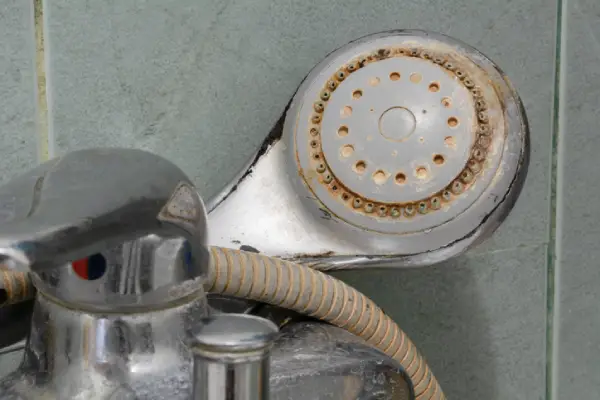
Limescale buildup on your showerhead can be a real nightmare. It not only looks unattractive but can also lead to low water pressure. Many Prescott homeowners tend to take off the showerhead for cleaning, but removing it can cause damage and, sometimes, even void the warranty.
Fear not! Our plumbers at Mr. Rooter, Plumbing of Yavapai, Coconino, & Maricopa Counties, have got you covered with this guide on how to remove limescale buildup on your showerhead without taking it off. And you’ll learn some alternative ways to keep limescale at bay.
Gather Your Supplies
Before diving into the cleaning process, ensure you have the necessary tools and supplies to adequately clean your shower head.
You'll need:
- White vinegar
- Baking soda
- A small plastic bag or Ziplock bag
- Rubber band
- A toothbrush or any small brush
The easiest and safest way to remove limescale buildup is by using natural cleaning products. Baking soda and white vinegar effectively break down mineral buildup without harming the showerhead’s finish.
Identify the Buildup and Clean the Showerhead
The next step is to identify the buildup on your showerhead. The green or white crusty deposits on the showerhead are typically limescale buildup. It’s a mineral deposit caused by hard water rich in calcium and magnesium.
Once identified, you need to remove any visible limescale. You can do this one of two ways:
- Option 1: Take an old toothbrush and dip it in vinegar. Then, scrub the showerhead, paying extra attention to the areas where limescale buildup is the most prominent. The vinegar will help dissolve the limescale and make it easier to remove.
- Option 2: Mix equal parts of white vinegar and baking soda in a plastic bag. Place the bag over the showerhead, ensuring that the showerhead is entirely covered. A rubber band may come in handy to help secure the bag and ensure it stays. Leave it to soak for 30 minutes to an hour, then rinse and wipe off the limescale residue.
When cleaning your showerhead with vinegar and baking soda, take some safety precautions. Vinegar is acidic and might cause skin irritation or eye irritation. So, wear gloves and protective eyewear to protect your skin and eyes from any potential harm.
Additionally, baking soda might cause breathing difficulties if inhaled, so ensure proper ventilation in your bathroom.
Regardless of how you clean limescale, the most important thing is that you make it a habit. Limescale can and will return if you’re not diligent about maintaining and disinfecting moist areas like your bathroom, appliances, etc.
Alternative Limescale Cleaning Hacks
If you don't have white vinegar or baking soda, there are other natural alternatives that you can use to clean your showerhead. For example, lemon juice can substitute for vinegar because it's acidic and dissolves mineral buildup. Similarly, a solution of water and salt can also remove limescale buildup.
Other Areas Limescale Can Appear
Limescale can build up in several places in a home, particularly in areas where hard water is frequently used.
Here are some common places where limescale tends to accumulate:
- Pipes: Limescale can accumulate inside pipes over time, potentially leading to blockages and reduced water pressure.
- Toilets: The bowl and inner components of toilets, especially the rim from where the water flows, can show signs of limescale buildup.
- Water Heaters and Boilers: These appliances heat water, accelerating limescale formation, resulting in reduced efficiency and lifespan.
- Dishwashers and Washing Machines: Limescale can build up on the heating elements and inside the machines, affecting performance and potentially damaging the appliance.
- Sinks and Bathtubs: Limescale deposits often form around the drain and on the surfaces of sinks and bathtubs, sometimes leaving a white or grey residue.
- Humidifiers: Since these devices use water to create humidity, they can also be where limescale accumulates.
Invest in a Water Softener System to Remove Hard Water
One of the ways to help prevent limescale due to hard water is by investing in a water softener system. A water softener is crucial in combating hard water issues in your home. Hard water is characterized by high mineral content, primarily calcium and magnesium, which can lead to limescale buildup in your pipes and appliances.
A water softener replaces these hard minerals with softer ones, such as sodium or potassium, through an ion exchange process. This prevents the formation of limescale and enhances the efficiency of soaps and detergents, leading to cleaner dishes, softer clothes, and smoother skin and hair.
Need to Get Rid of Hard Water and Limescale? Mr. Rooter Plumbing Can Help!
Removing limescale from a showerhead is less complex than you think! You can easily remove limescale buildup without removing the showerhead by using natural cleaning products like vinegar, baking soda, hydrogen peroxide, or lemon juice.
For a more permanent solution, trust our team at Mr. Rooter Plumbing of Yavapai, Coconino, & Maricopa Counties to recommend water filters and softeners to help remove the hard water that causes limescale. Our experienced plumbers in Prescott are ready to support you with exceptional plumbing solutions that can make home life a little easier.
Whether you need drain cleaning service, sump pump support, or water filter installation, our professionals can assist. Call us today!

